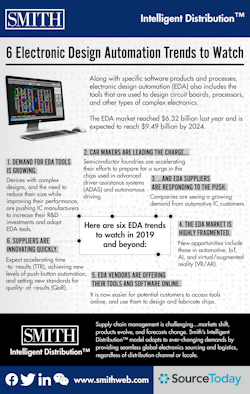As the software products and processes that help to design electronic systems with the aid of computers, electronic design automation (EDA) includes the tools that are used to design circuit boards, processors, and other types of complex electronics. Also known as electronic computer-aided design, EDA has largely replaced manual methods for circuit board and semiconductor design techniques.
In the past, technicians used tools like a photoplotter to render drawings of circuit boards and electronic components. Today, the same professionals largely rely on EDA tools that have standardized and streamlined the creation of circuit boards and chips through automation processes.
Those technicians are helping to drive a marketplace that’s expected to grow by about 7.8% annually (compound annual growth rate) between 2019 and 2024, according to a new Research and Markets report. In “Electronic Design Automation Tools (EDA) Market - Growth, Trends, and Forecast (2019-2024),” the research firm values the EDA market at $6.32 billion last year and says it will reach $9.49 billion by 2024.
“Electronic design automation (EDA) tools have provided the silicon industry with the ability to innovate over the past few years,” the report states. “The booming automotive, Internet of Things (IoT), and artificial intelligence (AI) sectors drive the growth of the semiconductor market, which requires electronic devices with complex designs.”
Here are six more EDA trends to watch in 2019 and beyond:
- Demand for EDA tools is growing. Growing demand for advanced electronic devices with complex designs, and the need to reduce the size while improving the performance of integrated circuits (ICs), are pushing IC manufacturers to increase their R&D investments and adopt EDA tools. “Therefore, the demand for EDA tools, compared to the other sectors, is expected to be high,” the research firm reports.
- Car makers are leading the charge…The automotive sector is a key driver of the overall EDA marketplace. Semiconductor foundries are accelerating their efforts in automotive chip production, for example, to prepare for a surge in semiconductors used in advanced driver-assistance systems (ADAS) and autonomous driving.
- …and EDA suppliers are responding to the push. According to Research and Markets, all of the major EDA vendors are working to expand their process portfolios for automotive customers. “The companies are seeing a growing demand from automotive IC customers amid the push toward traditional cars with more connectivity features - ADAS, and electric/hybrid vehicles,” the firm reports. “The automotive sector is also attractive because many devices don't require leading-edge processes, and hence, a large number of vendors can participate with less effort.”
- The EDA market is highly fragmented. New opportunities in the automotive, IoT, AI, and virtual/augmented reality (VR/AR) sectors have allowed semiconductor companies throughout all phases of the IC production cycle to prosper, with sizable revenue increases. “This has occurred despite significant gains in chip performance, but at relatively flat unit sales prices,” Research and Markets reports, noting that some of the key players in the industry include Mentor Graphics, Synopsis, and IBM.
- EDA vendors are offering their tools and software online. “Increased Internet penetration worldwide has made it easy for potential customers to access these tools online, and use them to design and fabricate chips,” Research and Markets writes in its report. “Consequently, the capital expenditure for companies has reduced because of reduced total cost of ownership (TCO) and infrastructure costs to accommodate these tools.”
- Suppliers are innovating quickly. For example, Synopsys recently announced its investment in AI design solutions to address the extreme complexities of leading-edge design. “The AI implementation was aimed at expanding the Synopsys Design Platform, accelerating time-to-results (TTR), achieving new levels of push-button automation, and setting new standards for quality-of-results (QoR) in digital and custom design,” Research and Markets reports.











